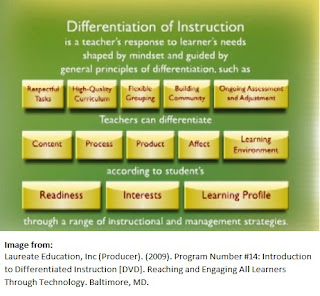
Image from
www.rf123.comThis class started by identifying diversity in the classroom. I thought I would be learning how to reach the diverse learners, the ones on the tails of the normal graph: students on IEP’s and gifted students. Now as I reflect on the course title, I realize I learned two teaching philosophies that are designed to reach all learners, because all learners are unique.
CAST, the Center for Applied Special Technology, has published information on brain research and identifies three brain networks at work during learning. Their Universal Design for Learning (UDL) outlines the What, How and Why of learning to help teachers design units so all students can access their content (Cast, 2007-2009). If you would like additional information, please visit my
prezi or CAST’s website at:
http://cast.org/udl/index.html.
Carol Ann Tomlinson has been a strong advocate for Differentiated Instruction, DI, which is a mindset for teachers that recognize all individuals can learn if teachers recognize each student’s unique learning style and differentiate by content, process and product according to a students’ readiness, interest and learning profile.

In understanding these two initiatives, I realize I have instituted some of these strategies, but there are additional adjustments I need to make to my practice. The first is to more accurately survey my students on their learning profile. How students interpret information is affected by their culture, gender, learning style and dominant intelligence. Knowing these traits about my students will allow both of us to understand the best pathways for content to be understood. I have four online surveys I created at Survey Monkey. Here is a link to one on Multiple Intelligences:
http://www.surveymonkey.com/s/V998NQ5.
The next area that I need to adjust in my practice is to rethink each unit holistically. I need to identify what each students needs to know, understand and be able to do(Laureate Education, 2009). Right now, each math lesson is taught followed by a practice worksheet. I need to devote more class time allowing students to process the content by having choice board activities based on multiple intelligences, here is my first attempt for a slope lesson:
Differentiation by Product Influenced by Profile / InterestVerbal/Linguistic: Create a cross word puzzle using at least 15 vocabulary words about slope. You may make one by hand or at
Discovery.com (Discovery Education, 2010)
Logical/ Mathematical: Play the slope
game and record how many you scored correctly
(Quia, 2011)
Musical: Make a song or rap to help us understand the formula or 4 orientations.
SampleKinesthetic: Using a yard stick, record the rise and run of 3 sets of stair/ramps in our school, calculate the slope of each.
Visual/Spatial: Complete online lesson at:
http://mathforum.org/te/exchange/hosted/miles/exploring_slope_using_an_interactive_applet.pdf (Dendane, 2003 - 2010 )
Naturalist: Research Statistics on your favorite mountain’s elevation and vertical drop and explain how slope is related. Find data like:
http://www.7springs.com/page/category.detail/nav/5010.html(Seven Springs Mountain Resort, 2011)
Intra-Personal: You have been asked to support your client, Ø slope in a discrimination suit; the other three slope orientations have refused to allow him to be present at the Slope Convention.
Inter-Personal: Create a skit with four characters: positive slope, negative slope, zero slope and Ø slope
You will notice five of the choices involve technology: drill and practice with immediate feedback, simulation or research. Technology integration is crucial to allow each student to have unique experiences and to allow them to create artifacts. Free online programs allow teacher many options for helping students make sense of content. Another powerful way to see what your students understand are free online concept mapping tools like
https://bubbl.us/ .

As I work my way through my master’s program, Integrating Technology into the Curriculum, at
Walden University, I realize it cannot all be done at once. There are changes I need to make to my lessons as I integrate
ISTE standards, design inquiry based lessons, and create differentiated activities. I need to research technologies for simulations, drill and practice, and technologies for students to create authentic products such as prezi and/or flip cameras. As I approach each lesson, I need to be thinking
“How can I make this content accessible to all?” and
“How can technology help?"References
Dendane, A. (2003 - 2010 ). Analyze math. Retrieved February 13, 2011, from Slope of a Line: http://www.analyzemath.com/Slope/Slope.html
Discovery Education. (2010). Discovery Education. Retrieved February 13, 2011 from Classroom Resources - Puzzlemaker: http://puzzlemaker.discoveryeducation.com/CrissCrossSetupForm.asp
McAleer, F. (2011, January 26). Learner's Link. Retrieved February 2, 2011, from Differentiating Instruction: http://www.learnerslink.com/
Laureate Education, Inc (Producer). (2009). Program Number #14: Introduction to Differentiated Instruction [DVD]. Reaching and Engaging All Learners Through Technology. Baltimore, MD.
Quia.(2011). Quia. Retrieved February 13, 2011, from Slope Formula: http://www.quia.com/quiz/248335.html
Seven Springs Mountain Resort. (2011). Seven Springs Mountain Resort. Retrieved February 13, 2011, from Slopes and Trails-Stats:
http://www.7springs.com/page/category.detail/nav/5010.html







 Technology is an ever changing field. Teachers, by definition, support the pursuit of knowledge. Those teachers who are passionate about technology have found an endless source of topics to research. But this research needs to be systematic.
Technology is an ever changing field. Teachers, by definition, support the pursuit of knowledge. Those teachers who are passionate about technology have found an endless source of topics to research. But this research needs to be systematic. 














 This week I finished reviewing my last 5 free online spreadsheets. EXpressoCorp was no longer available for new accounts as it will soon be integrated into Lotus Live, which will be a subscription service. InputWebWizard is not free, Peepel looks promising, but will not open. Sheetster was very buggy, the graph window appeared, but did not contain the graph. SimpleSpreadsheet only offered source code. Now I have reached my 20th spreadsheet to evaluate: ThinkFree. Despite its name, ThinkFree is not free. It is still in beta and may be one to watch as it has many of the features I am looking for based on my free 30 day trial evaluation.
This week I finished reviewing my last 5 free online spreadsheets. EXpressoCorp was no longer available for new accounts as it will soon be integrated into Lotus Live, which will be a subscription service. InputWebWizard is not free, Peepel looks promising, but will not open. Sheetster was very buggy, the graph window appeared, but did not contain the graph. SimpleSpreadsheet only offered source code. Now I have reached my 20th spreadsheet to evaluate: ThinkFree. Despite its name, ThinkFree is not free. It is still in beta and may be one to watch as it has many of the features I am looking for based on my free 30 day trial evaluation.



